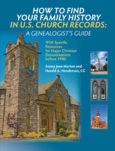Book Review: “How To Find Your Family History in U.S. Church Records”

I was excited at the opportunity to review “How to Find Your Family History in U.S. Church Records: A Genealogist’s Guide” by Sunny Jane Morton and Harold A. Henderson, CG. The book contains specific resources for researching ancestors in major Christian Denominations before 1900 in the United States. That excitement lasted throughout the whole book.
While censuses are great for providing us with a backbone of an individual’s or family’s timeline, Church records can help us learn the web of connections between family members and those who were close to them. The choice of Church may also give us the underlying motivations for major stories in our ancestors’ history. At the very least they provide us knowledge of the important institution and tenets with which our ancestors allied themselves.
This book is a game changer for religious research. Up until now, genealogists may have or may not have known the importance of church records, but conquering them was a hit-or-miss effort. These skills were usually taught by an experienced genealogist. A genealogist would learn a little about whom to contact and what to ask for, and that could still be a hit-or-miss effort. Experience was the only teacher.
In Section 1, Chapters 1 through 5 take the genealogist through the basics of researching Church Records. Section 2 addresses specific Christian denominations in the United States: Anglican/Episcopal, Baptist, Congregational, Dutch Reformed/Reformed Church in America, Latter-Day Saint (Mormon), Lutheran, Mennonite and Amish, Methodist, Quaker (Religious Society of Friends), Presbyterian and Roman Catholic. Each chapter contains a short history of the religion, important facts about it, followed by information about the records and how to find them. Every chapter also includes a section with resources for learning more.
One unexpected hidden gem in this book is that this approach may prove useful for those researching enslaved African-American ancestors. Some church records for them may exist in the Anglican/Episcopal Church, covered in Chapter 6.
I read this book from cover-to-cover, impressed by the amount of research put into each topic. The authors were clearly focused on putting useful and actionable information into genealogists’ hands. The authors are knowledgeable researchers, but put forth the additional effort of having experts in each religion review their material.
If you are thinking about trying to find your Christian ancestors in Church records, and you should be, this book is for you. This is an invaluable reference for those researching Christian Churches in the United States.
“How to Find Your Family History in U.S. Church Records: A Genealogist’s Guide” by Sunny Jane Morton and Harold A. Henderson, CG, is available from the Genealogical Publishing Company.



